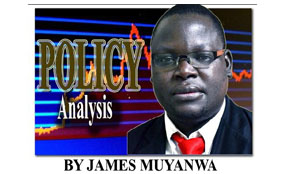 THE issue of public debt is becoming more important in Zambia but the answer to the question of whether to borrow or not has remained the matter of balancing.
THE issue of public debt is becoming more important in Zambia but the answer to the question of whether to borrow or not has remained the matter of balancing.
There is always need to weigh whether to borrow more or not depending on the usage for the resultant funds and whether a good return will be brought about by the investment of the borrowed funds.
These are some of the concerns which came to the fore on Thursday last week during a public discussion organised by the Economic Association of Zambia (EAZ) on Zambia’s public debts.
Two important points I got from the discussion led by the Zambia Institute for Policy Analysis and Research (ZIPAR) research fellow Shebo Nalishebo were that firstly, Zambia’s current debt stock is sustainable and secondly, that there is, however, cause for worries because it may soar to unsustainable level.
According to Mr Nalishebo the current total debt of about US$7.2 billion is still sustainable but there is cause to worry because it may become unsustainable by 2018.
Paradoxically, prior to the debt cancellation period under the Highly Indebted Poor Country (HIPC), external debt stock for Zambia was around US$7 billion.
The current total public debt, both domestic and external, however, translates into just slightly above 30 per cent of the Gross Domestic Product (GDP).
This is sustainable in that it is lower than the debt-to-GDP ratio of 40 per cent which is the suggested sustainable threshold for developing and emerging economies.
“Our debt is well within the recommended 40 per cent debt-to-GDP ratio,” Mr Nalishebo said.
Similar sentiments came from Mr Musonda Kabinga an official from the Jesuit Centre for Theological Reflection (JCTR).
Mr Kabinga, whose organisation fervently fought for the debt cancellation and relief through its Jubilee debt cancellation campaign, feels there is need to guard against the country degenerating back into the debt trap.
But like I have already indicated debts or loans in themselves are neither bad nor good.
They depend on many other factors including the cost of borrowing, the availability of other sources of income and
most importantly the intended use.
For today, I want to look at the justification for debt contraction and then next week I will look at the case against borrowing and some of the policy recommendations as espoused by the economic experts from the two think-tanks.
As already indicated the current debt is sustainable, meaning that there is room for more, depending on the usage.
According to Mr Nalishebo further argument for the debt is that the Government seems to have been increasing its borrowing from the domestic market without upsetting the debt sustainability thresholds.
This indicates that there are enough resources in the economy to go round, reflecting strong macro-economic fundamentals.
To the bank, the Government is a better alternative loanee than riskier categories of clients due to unpredictable business environment.
This makes lending institutions reluctant to engage with the private sector, especially the small time business people.
Government securities are a vital instrument for the conduct of indirect monetary policy operations and serves as collateral for lending in interbank markets. Central banks operating in well-developed domestic debt markets do not have to rely as much on direct controls like credit ceilings, interest rate controls and high reserve requirements.
Often, Zambians criticise the government for spending more money and call for more contribution from the mines, while yearning for better roads, schools, hospitals and other public goods.
When it comes to paying tax every citizen seems to be ready to avoid or even evade it whenever possible, leading to what Mr Nalishebo calls weak tax morality among the citizenry.
Therefore, the need for debt contraction is being compounded by this seeming feeble tax morality among the citizens.
The weak tax morality leads to low collection of revenue by Zambia Revenue Authority (ZRA) from the business community and individuals.
Should citizens, therefore, blame Government for resorting to borrowing if their tax morality is weak?
The need for borrowing is compounded by the fact that there is still some development gaps in the country, which require more investments.
For instance, the energy and transport infrastructure gobbled in excess of K6 billion in 2013, while expenditure on projects like the five-year Link Zambia 8000 and others is expected to continue in the
medium-term.
Given the low revenue collection by ZRA, which last year failed to meet the target, the Government is likely to incur more debts to finance deficits emanating from such expenditures unless the revenue
mobilisations improve
Comment: 0955431442,
0977246099 or email: jmuyanwa@gmail.com






